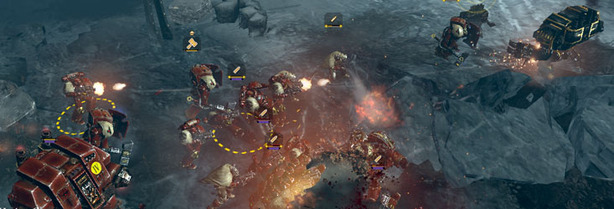
Call of Chaos
The introduction of Chaos is more than just for story-telling means too; it’s an ongoing attribute that your squads will need to either battle or embrace as the game goes on with the ending changing dramatically depending on how you played.Your squad’s morality is affected by a number of factors, one of which is your choice of equipment. War gear is dropped at random throughout missions and also from particularly tough enemies, with numerous unique pieces carrying either a corruption or holy factor. Using these bits of tainted/blessed kit can grant enormous combat benefits (especially for the tainted gear), but comes at the price of advancing your corruption level, itself bringing extra abilities dependant on how evil you’ve become. It may not be easy being evil, but it is rewarding.
In-mission decisions and performance also have an impact on your Chaos level, with slow progress resulting in the deaths of innocents or damaging a shrine to the God Emperor of Man Kind resulting in more Chaos points. There’s always a way back from the darkness though, with penitential items that cause your units to take increased damage or holy secondary objectives like preserving an imperial shrine allowing you to turn back the tide.
The problem is though that the Chaos route offers such tangible benefits, such as dramatically increased damage and unique abilities, that it’s by far the more entertaining way to play. While this is arguably a commentary on the ease with which anyone can slip to the dark forces, it still stinks of unfairness that staying pure in the eyes of the emperor offers little to no benefit, while being an evil, baby-eating bastard showers you with prizes.
Even then, the game often feels likes it’s punishing you with Chaos points rather than letting you make a conscious decision to turn to the darkside. Getting bogged down in enemies on the way to your objective and failing to rescue some stranded scouts doesn’t always mean you’re evil, it just means you’re rubbish, but the Chaos points will head your way regardless - apparently the baddies can't distinguish between the immoral and the plain inept.
Still, even with the clumsiness of the morality system, the much improved singleplayer campaign remains great fun for its eight hour duration (excluding the painfully tedious final battle) and the continued emphasis on both tight, squad based combat and special abilities delivers a strategy experience that’s still refreshingly unique despite the unwieldy size of the fiction.
Add in the chance to play as the Chaos faction themselves in multiplayer matches, a bunch of new multiplayer maps for all Dawn of War 2 players and some new game modes and Chaos Rising proves to be a pretty generous addition to the original. That's espeicially true in comparison to Relic's last expandalone, Company of Heroes: Tales of Valor. Perhaps the only huge grumble is the continued inclusion of Games for Windows Live for the multiplayer matchmaking system, although its presence in the single player campaign is thankfully minimal.
While little has changed at the core of the game to convert those who prefer their RTS with a healthy dose of base building, Relic has obviously taken a lot of the criticism aimed at Dawn of War 2 onboard and the result is a more linear, but much more entertaining title that proves a solid, if unremarkable expansion to one of our favourite modern strategy games.

MSI MPG Velox 100R Chassis Review
October 14 2021 | 15:04












Want to comment? Please log in.